No nonsense
Yesterday (and last thursday) I showed you a problem I have trouble with.
As you probably not know I'm a little self opinionated:). So if others give me good advice my first reaction is most of the time to think that it's nonsense.
But when I continue to struggle then very often I get back to the advice asking myself "what did he actually mean?"
The same happened with the advice that Takchess gave me last thursday on my pawn endgame problem.
This was (part of) the problem:
diagram 1
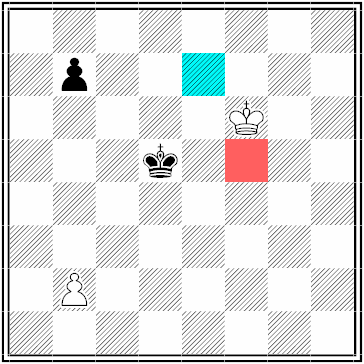
White to move and draw.
Why does 1.Ke7 draw while 1.Kf5 results in mate in 20?
The advice of Takchess was:
I suppose a way to solve this is to visualize the end position for a draw (there may be multiple options).Then determine what position is one move away from forcing that position. Then determine what position is two moves away from forcing that position. Then repeat as necessary.
After rejecting this advice as "nonsense" initially, I read it later carefully again and realized that it is actually a very good advice.
SOPE said about this position:
White has to watch out for both methods of defence (attack against the black pawn and defending his own pawn, or the key squares)
This gives a hint, but it is actually very vague.
To judge which way to go every move you need much more precision.
If you don't know exactly which squares to head for, you are actually gambling.
The method of Takchess revealed much of the subtleties of the position.
Actually there is not 1 end to this variation but there are 4 possible ends that draw.
Let's have a closer look at them.
diagram 2
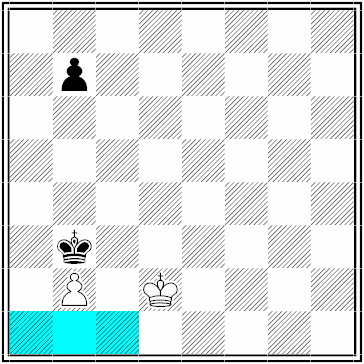
White to move.
If white wants to defend his own pawn, to which square does he have to head?
The diagram shows that reaching the key square c1 is essential for this method of defense.
This is the reason why 1.Kf5 in the first diagram doesn't work.
If the white king goes to the south along the f-file, black can shoulder him away along the d-file. So the white king will never reach c1 in time.
diagram 3
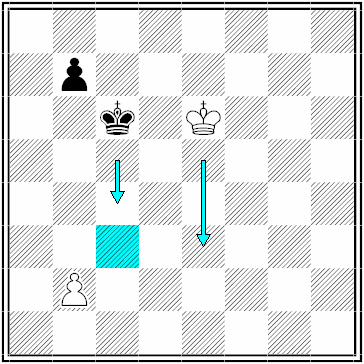
Black to move.
This diagram show a subtlety why white has to move along the e-file while heading to c1.
There comes a moment the black king can't follow because he is blocked by c3.
If you decide to sacrifice your pawn, you have to know where your king has to head for to defend the key squares of the black pawn in time.
The next diagram gives you a clue.
diagram 4
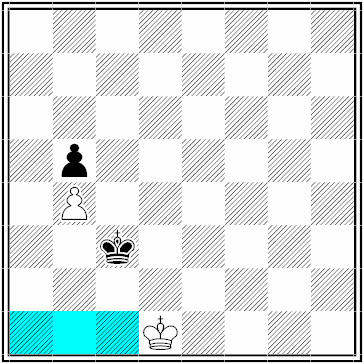
Black to move.
To block the black king after sacrificing your pawn, you have to be in time on b2.
That means that in this position you have to be allready on one of the blue squares.
So here again you find c1 to be the square to head for from the initial position.
What about the other method of defense?
This can be a possible end of the line when you decide to head for the black pawn.
diagram 5
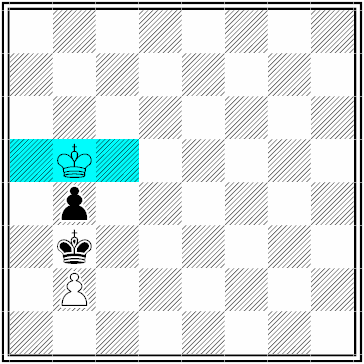
Black to move.
If you keep the distance between your king and the opponents' at 1 square, he never can fetch your pawn. If you decide to give your pawn away in this position, you have to be sure that you catch his one in time.
The following diagram gives you a clue where your king has to be.
diagram 6

White to move.
When you reach the blue squares in time you can prevent the connection of the black pawn and the black king. The blue squares can be derived from the red one, the last square before the black pawn reaches its refuge.
So Takchess is right.
Before you can do such lines OTB you have to have a database of such positions. Otherwise you have no clue what you are doing.
The keyword is precision.
What is incomprehendsible is that I wasn't prepared for these difficulties. If you look on the web nobody talks about these difficulties. The same is true for the booklet of Nunn and the big book on endgames of Euwe. Relatively spoken SOPE is an exception. That's why I bought it in the first place. But even they are somewhat vague about this position, as you can see above.
What's the matter?
Am I so stupid that I'm the only one who has this problem?
Do other people have the same problem but don't they realize they do?
As I said before, even grandmasters fail sometimes at these positions in official games.
Is there a psychological buffer at work which makes us to deny such difficulties?
Or is it a conspiracy?
As you probably not know I'm a little self opinionated:). So if others give me good advice my first reaction is most of the time to think that it's nonsense.
But when I continue to struggle then very often I get back to the advice asking myself "what did he actually mean?"
The same happened with the advice that Takchess gave me last thursday on my pawn endgame problem.
This was (part of) the problem:
diagram 1

White to move and draw.
Why does 1.Ke7 draw while 1.Kf5 results in mate in 20?
The advice of Takchess was:
I suppose a way to solve this is to visualize the end position for a draw (there may be multiple options).Then determine what position is one move away from forcing that position. Then determine what position is two moves away from forcing that position. Then repeat as necessary.
After rejecting this advice as "nonsense" initially, I read it later carefully again and realized that it is actually a very good advice.
SOPE said about this position:
White has to watch out for both methods of defence (attack against the black pawn and defending his own pawn, or the key squares)
This gives a hint, but it is actually very vague.
To judge which way to go every move you need much more precision.
If you don't know exactly which squares to head for, you are actually gambling.
The method of Takchess revealed much of the subtleties of the position.
Actually there is not 1 end to this variation but there are 4 possible ends that draw.
Let's have a closer look at them.
diagram 2

White to move.
If white wants to defend his own pawn, to which square does he have to head?
The diagram shows that reaching the key square c1 is essential for this method of defense.
This is the reason why 1.Kf5 in the first diagram doesn't work.
If the white king goes to the south along the f-file, black can shoulder him away along the d-file. So the white king will never reach c1 in time.
diagram 3

Black to move.
This diagram show a subtlety why white has to move along the e-file while heading to c1.
There comes a moment the black king can't follow because he is blocked by c3.
If you decide to sacrifice your pawn, you have to know where your king has to head for to defend the key squares of the black pawn in time.
The next diagram gives you a clue.
diagram 4

Black to move.
To block the black king after sacrificing your pawn, you have to be in time on b2.
That means that in this position you have to be allready on one of the blue squares.
So here again you find c1 to be the square to head for from the initial position.
What about the other method of defense?
This can be a possible end of the line when you decide to head for the black pawn.
diagram 5

Black to move.
If you keep the distance between your king and the opponents' at 1 square, he never can fetch your pawn. If you decide to give your pawn away in this position, you have to be sure that you catch his one in time.
The following diagram gives you a clue where your king has to be.
diagram 6

White to move.
When you reach the blue squares in time you can prevent the connection of the black pawn and the black king. The blue squares can be derived from the red one, the last square before the black pawn reaches its refuge.
So Takchess is right.
Before you can do such lines OTB you have to have a database of such positions. Otherwise you have no clue what you are doing.
The keyword is precision.
What is incomprehendsible is that I wasn't prepared for these difficulties. If you look on the web nobody talks about these difficulties. The same is true for the booklet of Nunn and the big book on endgames of Euwe. Relatively spoken SOPE is an exception. That's why I bought it in the first place. But even they are somewhat vague about this position, as you can see above.
What's the matter?
Am I so stupid that I'm the only one who has this problem?
Do other people have the same problem but don't they realize they do?
As I said before, even grandmasters fail sometimes at these positions in official games.
Is there a psychological buffer at work which makes us to deny such difficulties?
Or is it a conspiracy?
I would have difficulty solving the problem over the board. However given the correct solution I think I would find it much easier to figure out the actual moves necessary to solve it. Sort of like Takchess mentioned in his reply to you. Once you know the "dream position" its easier to achieve the goal. My problem is figuring out which dream position I calculate too. Under the constraints of time pressure an endgame like that leads to guessing and my guess would likely have lead to Kf5 as well.
ReplyDeleteAs a master of single pawn endgames, you must be aware of certain endgame techniques. In the endgame tactics still play a role, but new tools like Opposition, and Outflanking come into play.
The original problem for this thread is based on should white attempt to gain the opposition or outflank the opponent. I think maybe doing a few more problems on these themes may shed more light for you. Maybe you could check out Pandolfini's endgame course, which should have some nice examples of each.
This comment has been removed by a blog administrator.
ReplyDeleteNo you're not. Endgames, no matter how simple they appear to be, are harder then they look. It isn't just for nothing Capablanca once said that "endgames teach you chess"... Endgames might be the hardest part of chess alltogether. And at the same time the most underestimated part to be studying. A lot of people (who are probably not really serious about chess) tend to think like, oh i'll see what i'll do when i reach it...
ReplyDeleteThen again, this is just my personal opinion.
Qh7#,
ReplyDeleteI work with SOPE, which has 420 pawn endings exercises, I have Chess endgame training from Convekta with 234 pawn endings, I have papa Polgars endgame brick with 100 pawn endings. But when I run out of exercises I will have a look at Pandolfini's course:)
«Why does 1.Ke7 draw while 1.Kf5 results in mate in 20?»
ReplyDeleteI think there are two approaches for electing the better one of two candidate moves.
The first one is to calculate lines, and this can be very long ones in endgames. Who can calculate 20 moves to a mate? I cannot.
The second one is rules of thumb. Such a rule will tell me that Ke7 gains space (approaching the b-file) whereas Kf5 does not. So Ke7 must be the right move.
No, I am no master of endgame. It often happens to me that I chose the wrong of two conflicting rules of thumb :(
Never underestimate psychology in a game. It's effected the resulted of many a game.
ReplyDeleteTempo,
ReplyDeleteIn no way shape or form do I think you are crazy for finding endgames tough to grasp. Why do you think both Jim and I given the option by IM Trajkovic to study anything we want have both (separately) chosen to focus on end games?
There is hope though, it is a lot easier (for me anyway) to have someone explain the key concepts to you as opposed to reading them out of a book. IM Trajkovic is excellent at
making things really simple. The really funny thing is once you grasp the concept you realize there isn’t as much calculation involved with endings as you once thought.
It’s more like “all I have to do is be here when my opponent goes to square-X”.
Another really cool thing is once you learn an ending concept it never changes, and you start getting ideas on how to build or bridge into endings you already understand.